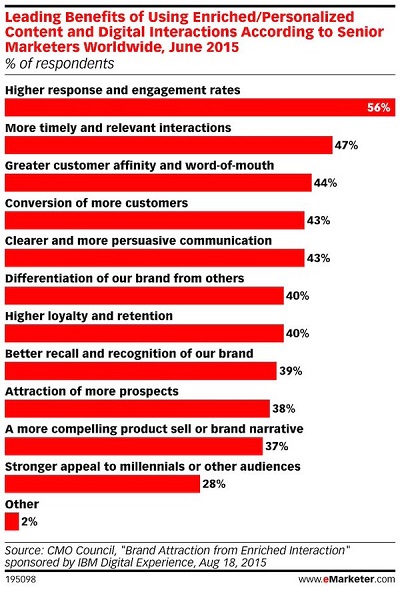Hyper-personalization or ‘personalized marketing at scale’, is where Big Data and online marketing intersect. This new marketing buzzword denotes more than a passing phase—it’s part of an irreversible evolution in marketing that targets individuals with content that is tailored to them. This is marketing done smarter, and it’s a technique you need to know about.
This new world of personalized marketing presents both opportunities and risks for marketers. We must seek to engage with our audience without being creepy or overstepping privacy boundaries.
We all know that blanket TV ads are becoming increasingly less effective. It’s time to look at hyper-personalization to boost engagement and generate demand. Nearly 6 in 10 marketers say that personalizing content is a crucial part of their strategy, and we think that number will only increase in the foreseeable future.
With so many experts in agreement, it’s time to face the facts. This isn’t a fad; it’s a technique that’s here to stay, and it will permanently and irreversibly change how marketing is done.
There are three key techniques we need to focus on. Let’s look at them briefly:
Being represented on social media isn’t enough any more. The number of likes, shares and follows is irrelevant. What matters is the one-to-one connection that is created with a personalized approach. On social media, hyper-personalization means actively listening to individuals and then engaging in a conversation with them.
Hyper-personalization is married to Big Data. It cannot exist without it. So we need to update our data management strategies and look at ways to enrich what we know. Using a CRM is no longer enough. We need to capture profile information, scan social networks, look for relevant hashtags, and enhance our data with third-party sources. We all need to put more effort into maintaining a high level of data quality.
Content is still king in this new age of marketing, but hyper-personalization implies that content needs to be personal and targeted. This is essentially the Holy Grail of content marketing. We need to track people, tailor our message, and create content for the individual.
Hyper-personalization is intrinsically linked with providing exceptional customer service and triggering loyalty that results in increased frequency of purchases.
Customers increasingly expect a business to know who they are, and what they want, and hyper-personalization allows businesses to make that personal connection. In a report by Infosys, 59 per cent of shoppers who have experienced personalization believe it had a “noticeable influence” on their purchasing decisions. Marketers have many opportunities to leverage this competitive advantage.
It’s not just about creating loyalty; it’s about increasing spend, and that means giving customers more reasons to purchase, so that they come back and spend more frequently. These could include loyalty rewards, incentives, and coupons that tap into customers’ purchase triggers.
At the beginning of this article, we briefly mentioned that personalization has to strike a fine balance. It has to deliver the experience customers expect, without stalking them or invading their privacy.
Technology is providing the experience that customers are expecting, but it can also be responsible for making them feel like they’re being tracked or monitored by ads. There must be a guaranteed return in exchange for personal information, but marketers need to be cognizant of the issues around privacy and data gathering.
Consider these figures from an eMarketer survey:

Perhaps the most compelling reason to use hyper-personalized content is the uplift in response and engagement rates. In a study by the CMO Council, 56 per cent of surveyed marketers reported this as an outcome of personalized content and digital interactions.
2016 is the year that segmentation will wither and die. With all the data potentially available to them, marketers now have opportunities to develop relationships with customers through engaging personal interactions and thus obtain valuable insights.
The only way marketing teams can achieve this is to carefully analyze data, drill down to the granular details to figure out what their customers want, and build a picture from data gleaned through multiple channels. This highly focused approach can produce astonishing results.